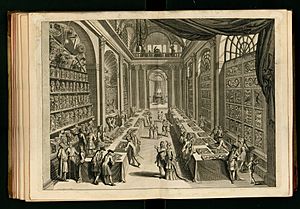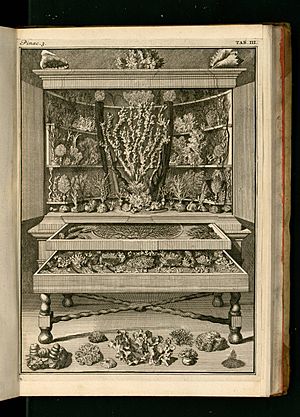Levinus Vincent facts for kids
Levinus Vincent the Younger (born in Amsterdam in 1658, died in Haarlem on November 8, 1727) was a very rich Dutch merchant. He was known for designing patterns and selling fancy fabrics. These included luxurious materials like silk and brocade.
About Levinus Vincent
Levinus Vincent was born in Amsterdam. His parents were Cornelis Joosten Heyns and Neeltje IJsbrants. In 1683, Levinus married Joanna van Breda. They lived in Amsterdam for many years. Around 1705, Levinus and his wife moved to Haarlem.
His Amazing Collection
Levinus Vincent was famous for his amazing collection. He had what was called a "cabinet of curiosities." This was a special room or cabinet filled with interesting objects. His collection included two main types of items:
- Naturalia: These were natural objects. He collected beautiful shells, insects, corals, and even preserved birds, lizards, and small mammals.
- Artificialia: These were man-made items. His collection had art, like paintings and drawings of flowers. It also included objects from different cultures around the world.
A Royal Visitor
In 1697, a very important person visited Levinus. This was Peter the Great, the Tsar of Russia! It shows how famous and impressive Levinus's collection was. Levinus also wrote letters to other important scientists. These included James Petiver and Hans Sloane. In 1715, he became a member of the Royal Society. This was a big honor for scientists and thinkers.
Sharing His Wonders
Levinus and his wife worked hard to make their collection special. They wanted it to be fun and educational for everyone. They arranged their shells and insects in beautiful patterns. These patterns looked like fancy embroidery.
Levinus wanted many people to see his collection. He even printed a special book about it. The book was called Wondertooneel der Nature, which means Wonder Theater of Nature. It was written in both Dutch and French. This way, more people could read about his collection. The book described all the objects he had.
Levinus had set visiting hours for people to come and see his collection. He even kept a visitor book! This book shows that over 3,500 people visited between 1705 and 1737. Famous visitors included Charles III of Spain.



